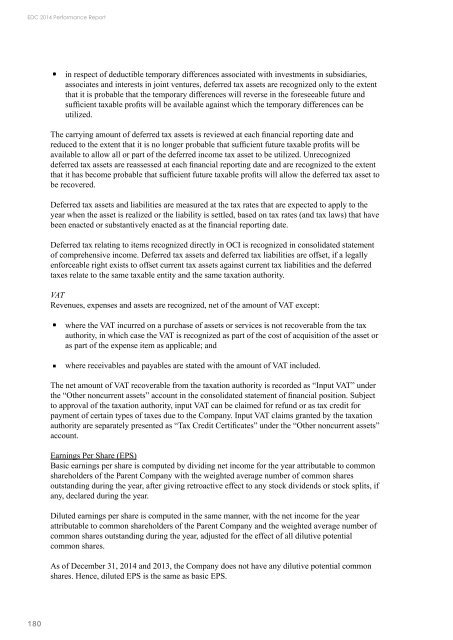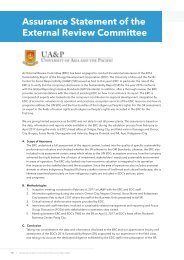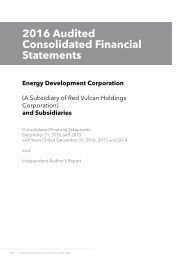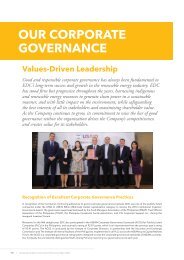EDC 2014 SR (UPDATED)
You also want an ePaper? Increase the reach of your titles
YUMPU automatically turns print PDFs into web optimized ePapers that Google loves.
<strong>EDC</strong> <strong>2014</strong> Performance Report<br />
in respect of deductible temporary differences associated with investments in subsidiaries,<br />
associates and interests in joint ventures, deferred tax assets are recognized only to the extent<br />
that it is probable that the temporary differences will reverse in the foreseeable future and<br />
sufficient taxable profits will be available against which the temporary differences can be<br />
utilized.<br />
The carrying amount of deferred tax assets is reviewed at each financial reporting date and<br />
reduced to the extent that it is no longer probable that sufficient future taxable profits will be<br />
available to allow all or part of the deferred income tax asset to be utilized. Unrecognized<br />
deferred tax assets are reassessed at each financial reporting date and are recognized to the extent<br />
that it has become probable that sufficient future taxable profits will allow the deferred tax asset to<br />
be recovered.<br />
Deferred tax assets and liabilities are measured at the tax rates that are expected to apply to the<br />
year when the asset is realized or the liability is settled, based on tax rates (and tax laws) that have<br />
been enacted or substantively enacted as at the financial reporting date.<br />
Deferred tax relating to items recognized directly in OCI is recognized in consolidated statement<br />
of comprehensive income. Deferred tax assets and deferred tax liabilities are offset, if a legally<br />
enforceable right exists to offset current tax assets against current tax liabilities and the deferred<br />
taxes relate to the same taxable entity and the same taxation authority.<br />
VAT<br />
Revenues, expenses and assets are recognized, net of the amount of VAT except:<br />
where the VAT incurred on a purchase of assets or services is not recoverable from the tax<br />
authority, in which case the VAT is recognized as part of the cost of acquisition of the asset or<br />
as part of the expense item as applicable; and<br />
where receivables and payables are stated with the amount of VAT included.<br />
The net amount of VAT recoverable from the taxation authority is recorded as “Input VAT” under<br />
the “Other noncurrent assets” account in the consolidated statement of financial position. Subject<br />
to approval of the taxation authority, input VAT can be claimed for refund or as tax credit for<br />
payment of certain types of taxes due to the Company. Input VAT claims granted by the taxation<br />
authority are separately presented as “Tax Credit Certificates” under the “Other noncurrent assets”<br />
account.<br />
Earnings Per Share (EPS)<br />
Basic earnings per share is computed by dividing net income for the year attributable to common<br />
shareholders of the Parent Company with the weighted average number of common shares<br />
outstanding during the year, after giving retroactive effect to any stock dividends or stock splits, if<br />
any, declared during the year.<br />
Diluted earnings per share is computed in the same manner, with the net income for the year<br />
attributable to common shareholders of the Parent Company and the weighted average number of<br />
common shares outstanding during the year, adjusted for the effect of all dilutive potential<br />
common shares.<br />
As of December 31, <strong>2014</strong> and 2013, the Company does not have any dilutive potential common<br />
shares. Hence, diluted EPS is the same as basic EPS.<br />
180
















